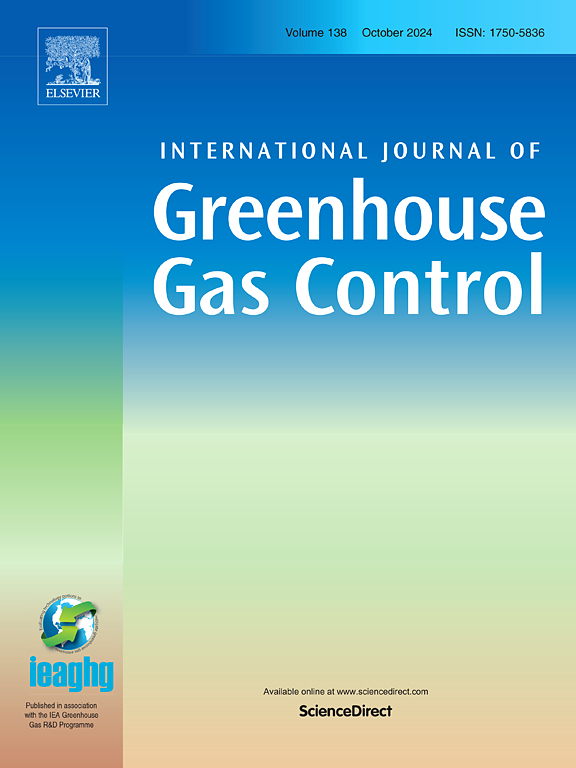3D reservoir quality estimation of the Lower Volpriehausen Unit in the Eastern German North Sea: A statistic and stochastic modelling approach
IF 5.2
3区 工程技术
Q2 ENERGY & FUELS
International Journal of Greenhouse Gas Control
Pub Date : 2025-07-14
DOI:10.1016/j.ijggc.2025.104435
引用次数: 0
Abstract
Carbon dioxide (CO2) storage in deeply buried sandstones can contribute to the mitigation of greenhouse gas emissions, particularly from hard-to-abate industrial sectors. Triassic sandstones of the Middle Buntsandstein Subgroup on the West Schleswig Block offer favourable conditions to act as potential storage reservoir. While previous studies focused on regional assessments of trap structures and static capacity estimations, this is the first assessment of the extent and quality of the reservoir itself. We have created a 3D model of the West Schleswig Block to assess the reservoir quality and spatial distribution of the basal sandstones of the Volpriehausen Formation, the primary reservoir of the Middle Buntsandstein Subgroup in this region, at top depths between 2121 m (P10) and 2854 m (P90). To this end, we have developed parameter models for shale content, effective porosity, and permeability to obtain regional trend maps. Our results show that the Lower Volpriehausen Unit exhibit good lateral continuity, with a median thickness of 43 m (ranging from 25 m to 85 m) and a mean porosity of 21 % (12 % - 28 %, P10-P90). Locally, low porosities are primarily caused by high shale content and diagenetic cementation. These findings indicate variable reservoir quality for formerly mapped reservoir structures on the West Schleswig Block, which has to be considered in future carbon storage exploration efforts. Our study can facilitate future developments in the screening and evaluation of potential storage sites in the German North Sea and presents a valuable resource for local CO2 storage capacity models.
德国东部北海低Volpriehausen单元的三维储层质量估计:一种统计和随机建模方法
将二氧化碳储存在深埋砂岩中可以有助于减缓温室气体排放,特别是来自难以减排的工业部门的温室气体排放。西石勒苏益格区块中Buntsandstein亚群三叠系砂岩具备作为潜在储层的有利条件。以前的研究集中于圈闭结构的区域评价和静态容量的估计,而这是第一次对储层本身的范围和质量进行评价。我们创建了西石勒苏wig区块的三维模型,以评估该地区中Buntsandstein亚群的主要储层Volpriehausen组的储层质量和空间分布,其顶部深度在2121 m (P10)至2854 m (P90)之间。为此,我们建立了页岩含量、有效孔隙度和渗透率的参数模型,以获得区域趋势图。研究结果表明,下Volpriehausen单元具有良好的横向连续性,中位厚度为43 m(范围为25 ~ 85 m),平均孔隙度为21% (12% ~ 28%,p10 ~ p90)。局部低孔隙度主要由页岩含量高和成岩胶结作用所致。这些发现表明,西石勒苏益格区块以前绘制的储层结构具有不同的储层质量,这在未来的碳储量勘探工作中必须加以考虑。我们的研究可以促进德国北海潜在储存地点的筛选和评估的未来发展,并为当地二氧化碳储存容量模型提供宝贵的资源。
本文章由计算机程序翻译,如有差异,请以英文原文为准。
求助全文
约1分钟内获得全文
求助全文
来源期刊
CiteScore
9.20
自引率
10.30%
发文量
199
审稿时长
4.8 months
期刊介绍:
The International Journal of Greenhouse Gas Control is a peer reviewed journal focusing on scientific and engineering developments in greenhouse gas control through capture and storage at large stationary emitters in the power sector and in other major resource, manufacturing and production industries. The Journal covers all greenhouse gas emissions within the power and industrial sectors, and comprises both technical and non-technical related literature in one volume. Original research, review and comments papers are included.

 求助内容:
求助内容: 应助结果提醒方式:
应助结果提醒方式:


